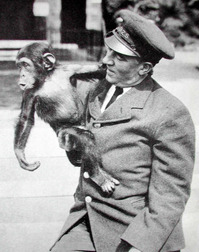PhD students discuss Know your Bristol
The Know Your Bristol events serve both to enhance the Know Your Place archive, building up a comprehensive and personal history of Bristol, and as a source of research and information for students studying the history of Bristol’s places.
PhD students Sarah-Joy Maddeaux and Andrew Flack share their thoughts on the Know Your Zoo event and discuss its contribution to their research and the history of Bristol Zoo.
How will the stories and memories shared with Know Your Bristol contribute to your research?
Sarah-Joy: From those stories I have listened to so far, they will strengthen my theory that the Zoo has played a significant part in locals’ conceptions of Bristol and their identification with and love of the city. It has emphasised how far the Zoo is an integral part of the city. Having this event has been key to getting wider evidence of this attitude, through being able to hear from a number of people in one go.
Andy: Given that my work is primarily concerned with analysis of attitudes and ideas surrounding human relationships with the rest of the natural world, individual understandings of animals are paramount. I’ve been interested in hearing about emotional connections between the Zoo’s visitors and animals they came to see. I’m also interested in how these attitudes contributed to physical treatment at the Zoo, from trade in animals to changes in display and encounter practices.
Were there any particular stories you enjoyed?
Sarah-Joy: Information about a former car parking attendant, which will contribute to the popular myth about an attendant taking the job upon himself and working independently of both the Zoo and the City Council.
Andy: I particularly enjoyed hearing memories of Alfred the gorilla, who lived at the Zoo from 1930-1948, and the way in which visitors related to him in a rather confused and contradictory manner. I also enjoyed hearing about elephant, camel and llama rides at the Zoo, all of which give an insight into multi-sensual ways of experiencing the animal spectacle.
What were your overall impressions of how the day went and its contribution to the history of Bristol Zoo?
Sarah-Joy: I enjoyed the day. We had some notable visitors, perhaps particularly the Lord Mayor and Lady Mayoress, who themselves have memories of childhood visits to the Zoo. I also appreciated the opportunity to meet some of the people who had already been in touch with us, to hear more about some of their memories and see some more of their photographs. In that sense the day made it much easier to follow up contacts. Digital copies of photographs and other documents collected on the day will enhance the Zoo’s archive by adding more from the visitor’s perspective.
Andy: The day went well. After the Zoo’s concentration on its history during its 175th birthday year in 2011, we hoped for a platform through which we could access deeper memories. This is what we got. The memories and photographs accessed during the day have allowed the Zoo to increase the richness of its archive. Moreover, collection of personal photographs on the day, which will be added to the archive to complement the Zoo’s collection of official images, allows for future researchers to access public ways of knowing animals on their visit to the Zoo.
